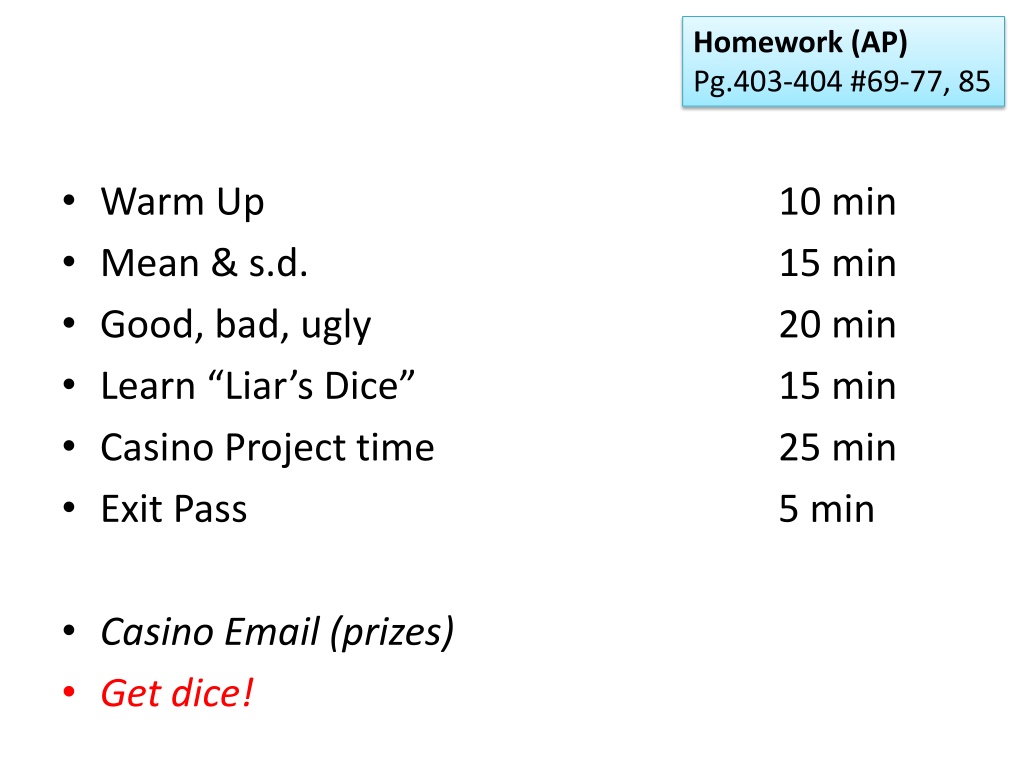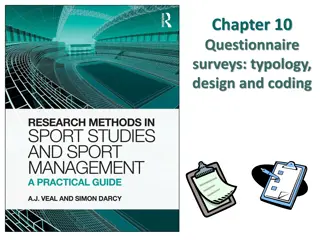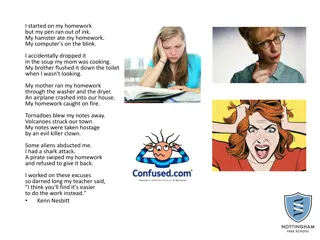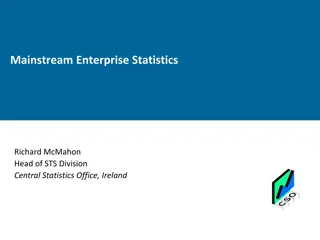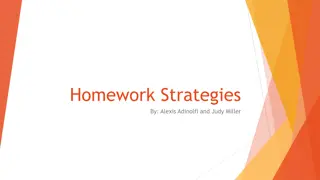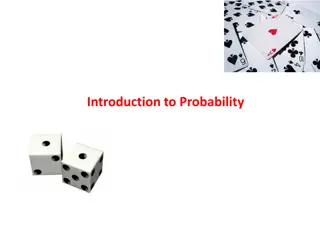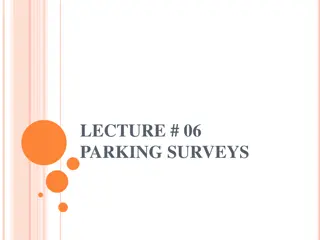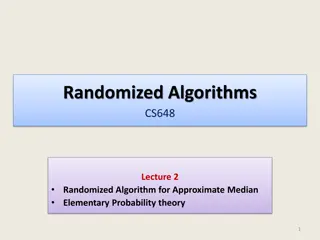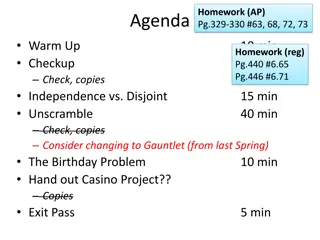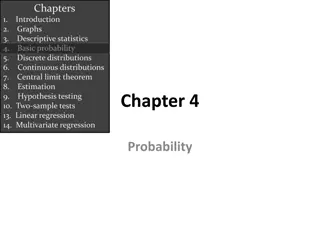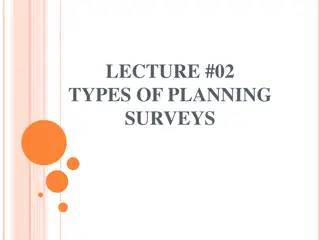Statistics Homework: Probability Problems and Surveys Analysis
This content covers probability problems related to genetic traits inheritance, shopping attitudes surveys, and coin fairness assessments. It includes calculations of the probabilities of specific outcomes based on given information. The material also involves analyzing survey data to determine agreement percentages and assessing whether a coin is judged to be biased or fair in a particular scenario.
Download Presentation

Please find below an Image/Link to download the presentation.
The content on the website is provided AS IS for your information and personal use only. It may not be sold, licensed, or shared on other websites without obtaining consent from the author. Download presentation by click this link. If you encounter any issues during the download, it is possible that the publisher has removed the file from their server.
E N D
Presentation Transcript
Homework (AP) Pg.403-404 #69-77, 85 Warm Up Mean & s.d. Good, bad, ugly Learn Liar s Dice Casino Project time Exit Pass 10 min 15 min 20 min 15 min 25 min 5 min Casino Email (prizes) Get dice!
Warm Up (choose one) 1. Offspring of a particular genetic cross have an undesirable trait with probability 1/8. Inheritance of this trait by separate offspring is independent. You examine 100 offspring from this cross and count the number X who have the undesirable trait. What is the probability that 10 or fewer of the offspring have this trait? 2. Are attitudes towards shopping changing? Sample surveys show that fewer people enjoy shopping than in the past. A survey asked a nationwide random sample of 2500 adults if they agreed or disagreed that I like buying new clothes, but shopping is often frustrating and time-consuming. Suppose that in fact 60% of all adult U.S. residents would say Agree if asked the same question. What is the probability that 1520 or more of the sample agree? 3. Is the coin fair? A coin is flipped 25 times. Let X represent the number of heads. The coin is judged to be fair if X is between 8 and 17, inclusive, and biased if X is outside this interval. What is the probability that the coin is judged to be biased when it is, in fact, fair ( false positive )?
1. Offspring of a particular genetic cross have an undesirable trait with probability 1/8. Inheritance of this trait by separate offspring is independent. You examine 100 offspring from this cross and count the number X who have the undesirable trait. What is the probability that 10 or fewer of the offspring have this trait? 1 = 100 ( , 10 , ) . 0 281 binomcdf 8 100 trials (n) 1/8 probability (p) 10 successes (x)
2. Are attitudes towards shopping changing? Sample surveys show that fewer people enjoy shopping than in the past. A survey asked a nationwide random sample of 2500 adults if they agreed or disagreed that I like buying new clothes, but shopping is often frustrating and time-consuming. Suppose that in fact 60% of all adult U.S. residents would say Agree if asked the same question. What is the probability that 1520 or more of the sample agree? = ( 1519 , 60 . 0 , 2500 ) 7868 . 0 binomcdf 7868 . 0 = 1 2132 . 0 2500 trials (n) 0.60 probability (p) 1519 successes (x)
3. Is the coin fair? A coin is flipped 25 times. Let X represent the number of heads. The coin is judged to be fair if X is between 8 and 17, inclusive, and biased if X is outside this interval. What is the probability that the coin is judged to be biased when it is, in fact, fair ( false positive )? 1 , 25 ( = binomcdf 1 binomcdf ) 7 , 2 0216 . 0 1 = ( 25 , 17 , ) 0217 . 0 2 + = 0216 . 0 0217 . 0433 . 0 25 trials (n) 1/2 probability (p) 7 or 17 successes (x)
Reminder I have review sessions after school every Thursday. Today is Unit 5, probability. Saturday 4/25 full-length practice exam
Important Senior info Final exam Final exam Cap-and-gown pickup Grad walk Grad practice, 4pm, Gym Grad tickets handed out after practice Check-out form due to counselors Senior trip Senior breakfast Graduation, 7pm, Raley Field Diploma pickup Senior sunset Last day of school Tues. 5/26 Wed. 5/27 Thur. 5/28 Fri.5/29 Mon. 6/1 Tues. 6/2 Wed. 6/3
Notes Mean and s.d. of Binomial 1 of 2 If you roll a die 900 times, how many three s do you expect? How much variability? np = = np 1 ( ) p Example: If you roll a die 900 times, and get 175 three s, do you conclude that the die is weighted? 150 ) 6 / 1 )( 900 ( = = = = 900 ( / 1 )( / 5 )( 6 ) 6 11 18 . 175 150 1 = . 2 24 = 1 binomcdf 900 ( , 175 , ) 01247 . 0 11 18 . 6 = 1 9875 . 0 0125 . 0
Example: FRQ 2011 #3 An airline claims that there is a 0.10 probability that a coach-class ticket holder who flies frequently will be upgraded to first class on any flight. This outcome is independent from flight to flight. Sam is a frequent flier who always purchases coach-class tickets. c. if Sam receives more than 20 upgrades to first class during the year? Justify your answer. np = 4 . 10 ) 1 . 0 )( 104 ( = = 4 . 10 20 = Sam will take 104 flights next year. Would you be surprised = = np 1 ( 104 ( ) p = 1 . 0 )( ) 9 . 0 )( . 3 059 . 3 14 = 1 binomcdf 104 ( , 1 . 0 , 20 ) . 3 059 0014 . 0 = 1 9991 . 0 0009 . 0
Notes Z-scores & Binomials 4 of 4 Assume Normality when sample size (n) is big enough. 10 np p 1 ( n ) 10 Assume Independence when population size (N) is big enough. N 10 n
Next slide I ve got three problems on the next slide, ordered by difficulty. Choose one of them.
Good, bad, ugly 1. Offspring of a particular genetic cross have an undesirable trait with probability 1/8. Inheritance of this trait by separate offspring is independent. You examine 100 offspring from this cross and count the number X who have the undesirable trait. What is the probability that 10 or fewer of the offspring have this trait? 2. Are attitudes towards shopping changing? Sample surveys show that fewer people enjoy shopping than in the past. A survey asked a nationwide random sample of 2500 adults if they agreed or disagreed that I like buying new clothes, but shopping is often frustrating and time-consuming. Suppose that in fact 60% of all adult U.S. residents would say Agree if asked the same question. What is the probability that 1520 or more of the sample agree? 3. Is the coin fair? A coin is flipped 25 times. Let X represent the number of heads. The coin is judged to be fair if X is between 8 and 17, inclusive, and biased if X is outside this interval. What is the probability that the coin is judged to be biased when it is, in fact, fair ( false positive )?
Good, bad, ugly 1. Offspring of a particular genetic cross have an undesirable trait with probability 1/8. Inheritance of this trait by separate offspring is independent. You examine 100 offspring from this cross and count the number X who have the undesirable trait. What is the probability that 10 or fewer of the offspring have this trait? Independence is assumed, we assume N>1,000 .that the population of offspring with this trait more than 10 times the sample size. Normality is met. np=12.5 and n(1-p)=87.5, both greater than 10. 1 = = 100 ( )( ) 12 5 . np 8 1 7 p = = 1 ( ) 100 ( )( )( ) . 3 31 np 8 8 2236 . 0 10 12 5 . = . 0 76 . 3 31
Good, bad, ugly 1. Offspring of a particular genetic cross have an undesirable trait with probability 1/8. Inheritance of this trait by separate offspring is independent. You examine 100 offspring from this cross and count the number X who have the undesirable trait. What is the probability that 10 or fewer of the offspring have this trait? 1 , 100 ( binomcdf = 10 , ) . 0 281 8
2. Are attitudes towards shopping changing? Sample surveys show that fewer people enjoy shopping than in the past. A survey asked a nationwide random sample of 2500 adults if they agreed or disagreed that I like buying new clothes, but shopping is often frustrating and time-consuming. Suppose that in fact 60% of all adult U.S. residents would say Agree if asked the same question. What is the probability that 1520 or more of the sample agree? Independence is met. N>25,000 .the population of American adults is more than 10 times the sample size. Normality is met. np=1500 and n(1-p)=1000, both greater than 10. = = ( 2500 . 0 )( 60 ) 1500 np p = = 1 ( ) ( 2500 . 0 )( 60 . 0 )( 40 ) 24 5 . np 1520 1500 7939 . 0 = = 1 2061 . 0 . 0 82 24 5 .
Good, bad, ugly 2. Are attitudes towards shopping changing? Sample surveys show that fewer people enjoy shopping than in the past. A survey asked a nationwide random sample of 2500 adults if they agreed or disagreed that I like buying new clothes, but shopping is often frustrating and time-consuming. Suppose that in fact 60% of all adult U.S. residents would say Agree if asked the same question. What is the probability that 1520 or more of the sample agree? 1519 , 60 . 0 , 2500 ( binomcdf = ) 7868 . 0 7868 . 0 = 1 2132 . 0
3. Is the coin fair? A coin is flipped 25 times. Let X represent the number of heads. The coin is judged to be fair if X is between 8 and 17, inclusive, and biased if X is outside this interval. What is the probability that the coin is judged to be biased when it is, in fact, fair ( false positive )? Independence is met. Contextually, coin flips are independent. Also, N>250. Normality is met. np=12.5 and n(1-p)=12.5, both greater than 10. 1 1 1 = = p = = ( 25 )( ) 12 5 . np 1 ( ) ( 25 )( )( ) 5 . 2 np 2 2 2 8 12 5 . 17 12 5 . = 8 . 1 8 . 1 = 5 . 2 5 . 2 0359 . 0 9641 . 0 0359 . 0 = 9641 . 0 9282 . 0 9282 . 0 = 1 0718 . 0
Good, bad, ugly 3. Is the coin fair? A coin is flipped 25 times. Let X represent the number of heads. The coin is judged to be fair if X is between 8 and 17, inclusive, and biased if X is outside this interval. What is the probability that the coin is judged to be biased when it is, in fact, fair ( false positive )? 1 , 25 ( = binomcdf 1 binomcdf ) 7 , 2 0216 . 0 1 = ( 25 , 17 , ) 0217 . 0 2 + = 0216 . 0 0217 . 0433 . 0
Liars Dice, rules Roll dice (hide from opponents). Loser decides who starts (may choose self) Players take turns. On your turn, you can . 1. Raise bet. Must say a higher bet. Bets are always at least bets. Bets are based on all dice on table. 1 s are wild (everything), unless someone bets 1 s. 2. Challenge . (can be said any time) All players reveal dice. Wrong person loses one die. 3. Exactly . All players reveal dice. Must be exactly that amount, no more, no less. If correct, all other players lose one die each. And repeat! Re-roll, start over. Winner = last player with dice.
Liars Dice Tournament Three Rounds 1st place = 2pts 2nd place = 1pt 3rd/4th place = 0pts Schedule: Round 1 Lecture Binomial probability & Liar s Dice Mini-worksheet in groups Round 2 Round 3 Top 3 go to Championship Round in front of class Includes me 3 dice each
Period 1 Round 1 1. Gabby E., Belinda, Gabriela H., Adeel 2. Megan, Harsha, Sydney, Omar 3. Athena, Megha, Andrew, Yuki 4. Nina, Keren, Brian, Daniel 5. Angie, Levani, Dipasha, Koa 6. Jada, Michael, Elian, Jonathan 7. Julia, Jack, Christian
Period 3 Round 1 1. Emily, Maribel, Drew, Joven 2. Hannah, Carolina, Laura, Jade 3. Ikram, Sangeeta, Charmay, Aidan 4. Diana, Tiarra, Alfonso, Dylan 5. Celia, Olivia, Lukas, Fatima 6. Hollie, Vanessa, Adam, Eleny 7. Eliseo, Mahek, Julian, Hassan 8. Alicia, Ally, Rajesh
Liars Dice, math Use binomial to win! EXAMPLE: I m playing with 3 other people (16 dice total). I have four dice, and three of them are 6 s or 1 s. I bet seven 6 s What are the chances I m right? There are 12 more dice. I need four more 6 s or 1 s. Three or less .I lose. 2 binomcdf = 1 12 ( , ) 3 , 6 . 0 607
More examples There are 13 dice left among all players, including me. I have 5 dice left, so the other players have 8 dice. Three of my dice are 5 s or 1 s. 1. If I bet five 5 s , what is the probability that I am right? 2 binomcdf = 1 , 8 ( ) 1 , 6 8049 . 0 2. If I bet seven 5 s , what is the probability that I am right? 2 binomcdf = 1 , 8 ( ) 3 , 6 2587 . 0 3. If I bet ten 5 s , what is the probability that I am right? 2 binomcdf = 1 , 8 ( ) 6 , 6 0026 . 0
Try it! worksheet
1. There are 15 dice left. You have 4 dice, with three 6 s. If you bet six 6 s , what is the probability that you are right? 2 binomcdf = 1 11 ( , ) 2 , 6 . 0 766 2. There are 10 dice left. You have 3 dice, with two 4 s. If you bet five 4 s , what is the probability that you are right? 2 binomcdf = 1 , 7 ( ) 2 , 6 4294 . 0 3. There are 18 dice left. You have 5 dice, with three 6 s. If you bet six 6 s , what is the probability that you are right? 2 binomcdf = 1 13 ( , ) 2 , 6 . 0 861 4. There are 16 dice left. But watch out, 1 s have been killed! You have 5 dice, with three 5 s. If you bet six 5 s , what is the probability that you are right? 1 binomcdf = 1 11 ( , ) 2 , 6 . 0 273
Liars Dice Tournament Three Rounds 1st place = 2pts 2nd place = 1pt 3rd/4th place = 0pts Schedule: Round 1 Lecture Binomial probability & Liar s Dice Mini-worksheet in groups Round 2 Round 3 Top 3 go to Championship Round in front of class Includes me 3 dice each
Period 1 Round 2 1. Adeel, Yuki, Keren, Gabby E. 2. Christian, Elian, Megan, Gabriela H. 3. Julia, Harsh, Sydney, Jack 4. Jada, Nina, Michael, Daniel 5. Omar, Athena, Jonathan, Dipasha 6. Belinda, Koa, Andrew, Megha 7. Angie, Brian, Levani,
Period 1 Round 3 1. Jonathan, Brian, Megha, Nina 2. Gabriela H., Michael, Gabby E. 3. Sydney, Levani, Megan, Omar 4. Andrew, Keren, Athena, Jack 5. Koa, Dipasha, Harsh, Angie 6. Daniel, Elian, Belinda, Jada 7. Yuki, Julia, Christian, Adeel
Period 3 Round 2 1. Adam, Rajesh, Laura, Dylan 2. Lukas, Maribel, Sangeeta, Ally 3. Eliseo, Diana, Hannah, Olivia 4. Hollie, Joven, Aidan, Eleny 5. Julian, Charmay, Drew, Fatima 6. Alfonso, Carolina, Tiarra, Mahek 7. Alicia, Ikram, Emily, Vanessa 8. Celia, Jade, Hassan
Period 3 Round 3 1. Fatima, Ally, Tiarra, Hannah 2. Eleny, Dylan, Drew, Sangeeta 3. Mahek, Olivia, Emily, Ikram 4. Hassan, Aidan, Laura, Carolina 5. Jade, Charmay, Maribel, Celia 6. Joven, Vanessa, Alicia, Hollie 7. Rajesh, Alfonso, Eliseo, Adam 8. Julian, Lukas, Diana
Casino Project (AP) Create, mathematically analyze, and run a simple gambling game which is significantly (but not obviously) in favor of you, The House . 1-2 people (2 recommended) Up to +5% extra credit for binomial probabilities and/or confidence intervals. Monday March 9th, due end of class: 1. List three possible ideas for your project. For each game, state how to play and how to win. Wednesday March 18th (or earlier), due end of class: 2. Choose one game and give it a catchy name. Describe your game (including the title), and calculate its probabilities and expected value. Tuesday March 24th: 3. Bring an attractive poster that explains your game, including prices and prizes. Bring all components needed for your game. Thursday March 26th: CASINO DAY! 7. Run your game, attract gamblers, and help them lose their money! You must profit at least $500 ($1000 total).
Homework (AP) Pg.403-406 #69-77, 85, 87, 89, 97 Exit Pass According to a 2000 study by the Bureau of Justice Statistics, approximately 2% of the nation s 72 million children had a parent behind bars nearly 1.5 million minors. Suppose that 100 children are randomly selected. Let X be the number of children who have an incarcerated parent. 1. Is X binomial? Justify. 2. Does your answer change if the children are sampled with replacement? Why? 3. Assume binomiality. Describe P(X=0) in a sentence, then calculate it. 4. What is the probability that 2 or more of the 100 children have a parent behind bars?
